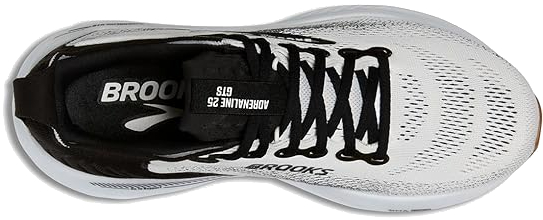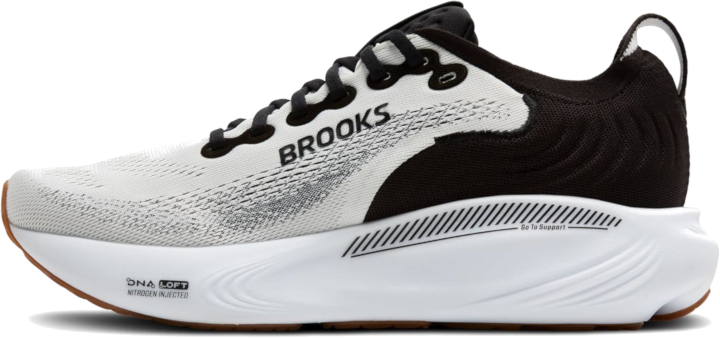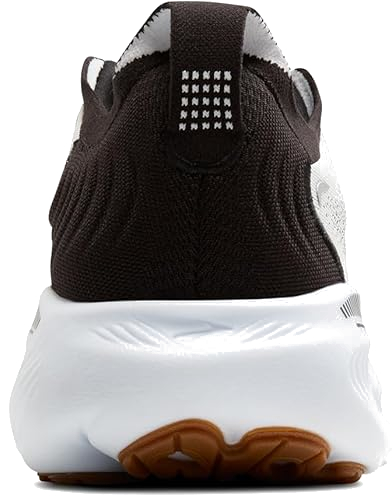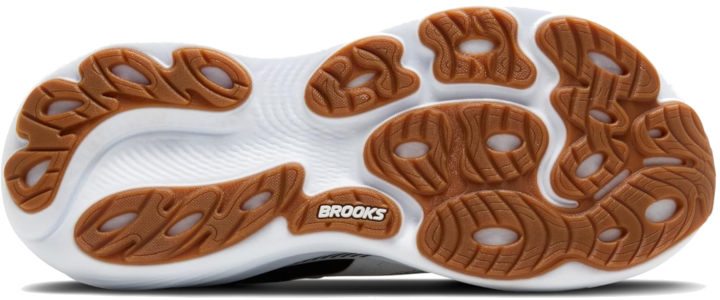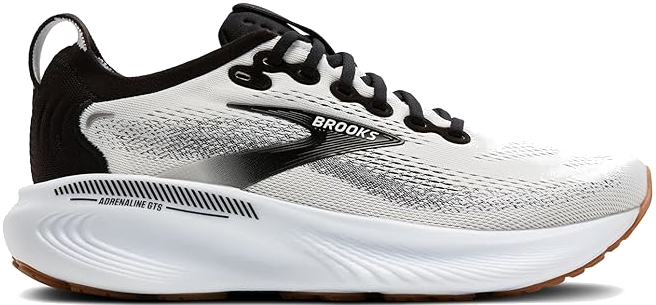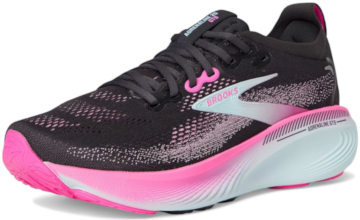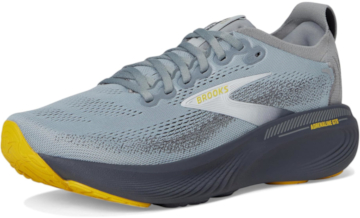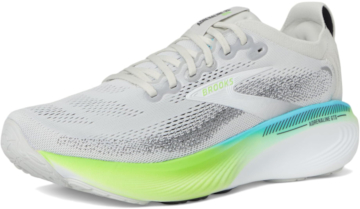The Brooks Adrenaline GTS 25 is back, and it’s softer, smoother, and more supportive than ever. This long-running favorite in the stability category now comes with a slightly lower 10 mm drop (down from 12 mm), which still classifies it as a high-drop shoe, ideal for taking pressure off your feet, ankles, Achilles, and calves during runs or all-day wear. The updated stack height of 37/27 mm adds 4 mm more foam in the forefoot, giving you a cushier, more balanced feel underfoot.
Yes, it’s 17 grams heavier than the previous model, but that added weight brings more comfort and protection where you need it most. For over two decades, the Adrenaline GTS has earned its reputation as one of the most trusted stability shoes for a reason; it delivers dependable support without feeling clunky or overbuilt. In this review, we’ll cover how the new version refines comfort, stability, and value for runners and walkers who want a shoe that works as hard as they do.
Table of Contents
- Key Specs at a Glance
- What’s New in the Brooks Adrenaline GTS 25
- Fit, Upper & Comfort
- Ride & Cushioning
- Stability & Support
- Outsole & Traction
- Durability & Value
- Pros & Cons
- Who Should Buy the Brooks Adrenaline GTS 25
- Final Verdict
- Brooks Adrenaline GTS 25 FAQs
Brooks Adrenaline GTS 25 Infographic

Key Specs at a Glance
- Heel-to-toe drop: 10 mm (2 mm deduction from the previous 12 mm drop)
- Weight: 9.5oz/269.3g Women, 10.6oz/300.5g Men (17 grams heavier than before)
- Stack height: 37/27 mm (4 mm more foam in the forefoot)
- Midsole foam: DNA LOFT v3
- Price: $155
What’s New in the Brooks Adrenaline GTS 25
The Brooks Adrenaline GTS 25 takes the familiar stability formula and softens it a bit. The updated DNA LOFT v3 cushioning delivers a smoother, lighter underfoot feel that’s kinder on your legs during daily runs or long walks. It’s not as responsive as the DNA Tuned foam, though, so if you’re chasing faster paces, you’ll have to work for it. This version isn’t built for marathon distances, but it’s a fantastic everyday stability trainer. Fit-wise, it runs true to size with a medium profile that’s easier to slip on, offering a slightly improved shape and better overall comfort than the GTS 24.
The double Jacquard mesh upper provides an excellent balance of breathability, structure, and stretch, with a soft inner lining that enhances comfort. It still carries the signature Adrenaline fit, secure yet forgiving, but now with more padding, which makes it feel a touch warmer on hot days. One standout improvement is the new heel bevel; it has improved a lot. It gives heel strikers a noticeably smoother landing and more efficient transition through the gait cycle. In short, the Adrenaline GTS 25 keeps everything runners love, reliability, support, and comfort, while refining the ride to feel slightly softer and more natural than before.
Fit, Upper & Comfort
The Brooks Adrenaline GTS 25 feels instantly comfortable the moment you slip it on. It fits true to size with a balanced medium width that should work well for most runners and walkers. The step-in feel is excellent, comfortable and secure, with enough structure to keep your foot stable without feeling locked down too tightly. The double Jacquard mesh upper offers a great mix of breathability, flexibility, and durability. It stretches slightly to accommodate foot shape while still holding you in during movement.
There’s also more padding around the heel collar and tongue, giving a soft, cushioned feel that helps eliminate pressure points during long hours of wear. The heel counter feels stable, and lockdown is confident even during brisk walks or light jogs. It’s not as airy as some performance trainers, especially with the added padding, so it can feel a bit warmer in hot weather, but that’s the trade-off for the comfort and support it delivers.
Underfoot, the DNA LOFT v3 foam makes the Adrenaline GTS 25 feel smooth and stable, though it’s not particularly springy. It’s slightly softer than before, but because it’s less responsive, it doesn’t shine in fast runs or long-distance efforts. Where it truly excels is in walking, recovery days, and all-day standing comfort. The added foam increases underfoot cushioning and stability, keeping fatigue at bay during extended wear.
Visually, Brooks has also stepped up its game—the Adrenaline GTS 25 looks more modern and premium than its predecessor, with cleaner lines and slightly upgraded materials. It’s the kind of shoe that performs just as well for your morning walk as it does for casual all-day wear, offering comfort, support, and style that make it one of the most reliable stability trainers in 2025.
Ride & Cushioning
The Brooks Adrenaline GTS 25 offers a softer and slightly higher ride than before, thanks to the extra 2 mm of stack height that adds noticeable cushioning, especially under the forefoot. The DNA LOFT v3 midsole feels comfortable and protective underfoot, yet it maintains just enough firmness to keep the shoe stable during each stride. It’s not the kind of foam that gives you springy energy return; instead, it delivers a smooth, steady ride that prioritizes comfort and control. You’ll feel supported, not propelled, which is exactly what many stability runners want.
That added structure comes from the GuideRails technology, Brooks’ signature stability system that gently keeps your foot aligned without feeling intrusive. It works naturally in the background, correcting excess inward roll (overpronation) and keeping your gait efficient. Unlike some stability shoes that feel overly rigid, the Adrenaline GTS 25 has a bit more flexibility in the forefoot, allowing smoother toe-offs during walking or easy runs. However, this flexibility might not suit runners who experience forefoot discomfort or need extra rigidity in that area.
The medial support is outstanding, you can feel it from heel to midfoot, where it effectively prevents the arch from collapsing. This gives you a feeling of confidence on every step, especially on longer walks or recovery days. One thing to note, though: while earlier Adrenaline models worked well for both overpronators and slight supinators, this new version leans more toward stability control. The lateral side compresses more easily, which may not be ideal if you tend to roll outward.
Overall, the Adrenaline GTS 25 delivers a controlled, cushioned, and reliable ride that favors support and balance over speed. It’s the kind of shoe that helps your body feel good after long days of movement, whether you’re walking miles, standing on hard floors, or logging easy runs.
Stability & Support
If there’s one thing the Brooks Adrenaline GTS series has always nailed, it’s stability that feels natural, and the GTS 25 continues that legacy with subtle refinements. The GuideRails technology does an impressive job of controlling excess motion without making the shoe feel restrictive. Instead of forcing your foot into a rigid position, the GuideRails gently guide your stride back into alignment when you start to roll inward. It’s a more modern approach to stability, one that keeps your knees, hips, and ankles in check without overcorrecting your gait.
For runners with mild to moderate overpronation, this system hits the sweet spot. It offers dependable medial support from the heel through the midfoot, helping to prevent arch collapse and reduce fatigue on longer efforts. The shoe’s stable base and added foam height also improve balance and ground contact, giving you a steady, confident feel even on uneven surfaces.
What’s nice is that you get this support without the bulky, overbuilt feel that older stability shoes were known for. The Adrenaline GTS 25 feels secure yet smooth, letting you move naturally while still protecting against unwanted inward roll. Whether you’re logging daily runs, long walks, or standing on your feet for hours, this is a shoe that keeps your stride steady and your joints happy.
Outsole & Traction
The outsole of the Brooks Adrenaline GTS 25 shows that Brooks isn’t cutting corners when it comes to grip and longevity. There’s more rubber coverage this time around, particularly in the high-wear zones under the heel and forefoot, which translates to better traction and improved durability. The tread pattern offers reliable grip whether you’re walking on smooth tile, pounding pavement, or jogging on a treadmill. It feels confident underfoot, even on slightly wet roads, something stability runners will appreciate.
Brooks shoes have long been known for their dependable traction, and the GTS 25 continues that tradition. The outsole design helps create smooth transitions from heel to toe while providing a stable platform for daily runs or extended walking sessions. It’s built to handle 300–500 miles before showing significant wear, making it a strong option for runners or walkers who want lasting value.
Whether you’re logging miles on the road, hitting the treadmill for steady runs, or wearing it casually throughout the day, the Adrenaline GTS 25’s outsole delivers a balance of grip, flexibility, and durability that keeps you moving securely and comfortably mile after mile.
Durability & Value
At $155, the Brooks Adrenaline GTS 25 sits in the premium range for stability shoes, $15 more expensive than the previous model. The build quality is solid, from the upper materials to the outsole rubber, but it’s not the most durable stability shoe out there. Expect reliable performance for roughly 300–500 miles, depending on your running style and surface. It holds up well for everyday training, walking, and treadmill miles, but heavier runners or high-mileage users might see midsole compression a bit sooner.
When compared to its rivals, the Adrenaline GTS 25 lands slightly on the pricier side. It’s $5 more expensive than the Saucony Guide 18, $15 more than the Mizuno Wave Inspire 21, and $15 more than the New Balance Fresh Foam X 860v14, and between those, the 860v14 will let you run faster with less effort. The Wave Inspire 21, with its ENERZY NXT supercritical foam, arguably delivers the best value for performance and price.
That said, the Adrenaline GTS 25 isn’t trying to out-bounce or out-speed the competition; it’s about dependability. You’re paying for a shoe that’s been trusted by countless runners over the years for its consistent comfort, proven stability, and smooth, no-surprises ride. For those who prioritize reliability over innovation, the Adrenaline GTS 25 remains a classic worth the investment.
Pros & Cons
Pros
- Slightly softer and more cushioned than before, thanks to the updated DNA LOFT v3 midsole
- Excellent stability from the refined GuideRails system that controls overpronation naturally
- True-to-size fit with better step-in comfort and improved lockdown
- More padding in the heel and tongue for all-day comfort
- Double Jacquard mesh upper balances breathability, stretch, and structure
- More outsole rubber for better traction and longer wear (300–500 miles expected)
- Smooth heel-to-toe transitions, especially beneficial for heel strikers
- A trusted, dependable ride that works great for walking, recovery days, and daily wear
Cons
- Heavier than the previous model by about 17 grams
- Less responsive midsole requires more effort for faster runs
- Can feel warm in hot weather due to added padding
- Not ideal for long-distance running or speed workouts
- Slightly more expensive than key competitors (Saucony Guide 18, Mizuno Wave Inspire 21, NB 860v14)
- Less suitable for supinators, as the lateral side compresses more on impact
Who Should Buy the Brooks Adrenaline GTS 25
Who Should Buy the Brooks Adrenaline GTS 25
- Runners dealing with mild to moderate overpronation who want a trusted stability shoe with refined support.
- Walkers or people on their feet all day seeking cushioned comfort with a stable ride; this model performs well for extended wear.
- Heel-strikers or anyone looking for a slightly higher drop (10 mm) to offload stress from the calves, Achilles tendon, and lower leg.
- Daily trainers and joggers who prioritise consistent support, comfort, and reliability over high-speed performance or ultralight feel.
Who Shouldn’t Buy It
- Runners focused on speed-training, tempo runs, or racing, the DNA LOFT v3 foam offers smoother comfort but lacks the bounce of more performance-oriented shoes.
- Supinators (those whose feet roll outward) who need more lateral rigidity; this design leans toward medial support and might not suit outward motion control.
- Budget-conscious buyers or those looking for top value in every category, a few competitors deliver similar stability at lower cost or higher performance.
Final Verdict
The Brooks Adrenaline GTS 25 continues to uphold its legacy as a dependable stability shoe, offering a refined ride with the right blend of comfort, structure, and everyday usability. If you’re a runner with mild to moderate over-pronation, or someone who spends long hours on their feet and wants reliable support, this is a strong choice.
Here’s what stands out:
- The updated DNA LOFT v3 midsole adds noticeable softness without sacrificing the stability that athletes expect from the Adrenaline line.
- The improved upper, double Jacquard mesh, better fit and more padding, gives you luxe comfort and a modern look.
- The updated GuideRails system keeps excess inward motion in check gently, making it supportive without being bulky.
- Excellent for walking, recovery runs, standing shifts, or daily training thanks to its combination of foam, drop, and stable platform.
That said, it’s not flawless:
- The ride isn’t built for speed—if you’re chasing tempo runs, races or maximal bounce, there are better-suited options.
- It’s slightly heavier and pricier than some rivals, which may matter if you compare purely on value or weight.
- If your gait pattern is supination or you favour ultra-light, ultra-flex forefoot feel, you might notice its limits.
Bottom Line: Go with the Adrenaline GTS 25 if you prioritise reliability, comfort and support over flash-speed and feather-weight. It continues to deliver that trusted “run all day, walk all day” stability that many loyal users have appreciated for years.
Heads up: As an Amazon Associate, we earn from qualifying purchases.
Brooks Adrenaline GTS 25 FAQs
If you’re considering the Brooks Adrenaline GTS 25, you probably have a few questions about how it performs, fits, and compares to other stability shoes. Below are some of the most common questions runners and walkers ask before deciding if this shoe is the right match for their needs.
Is the Brooks Adrenaline GTS 25 good for walking or standing all day?
Yes. With its soft DNA LOFT v3 cushioning and stable GuideRails system, it’s one of the most comfortable stability shoes for long hours on your feet. It offers excellent arch support, smooth transitions, and enough structure to prevent fatigue.
How much does the Brooks Adrenaline GTS 25 weigh?
9.5oz/269.3g women and 10.6oz/300.5g men. It’s about 17 grams heavier than the previous version, but still within the daily trainer range. The added weight comes from extra foam and padding for better comfort and support.
What’s the heel-to-toe drop and stack height?
The shoe now has a 10 mm drop (down from 12 mm in the GTS 24) with a stack height of 37 mm at the heel and 27 mm at the forefoot, offering a softer, more balanced underfoot feel.
Is the Adrenaline GTS 25 suitable for neutral runners?
It’s designed for mild to moderate overpronators, but neutral runners who like extra stability may also find it comfortable. However, if you don’t need support features, you might prefer the Brooks Ghost 17, which offers a similar cushion feel without the GuideRails system.
How does the Brooks Adrenaline GTS 25 compare to the GTS 24?
The GTS 25 is slightly softer, smoother, and more refined. It has more foam in the forefoot, a lower drop, and improved upper comfort. The new heel bevel also helps with smoother landings, especially for heel strikers.
How long will the Brooks Adrenaline GTS 25 last?
Expect around 300–500 miles of use depending on your weight, running style, and surfaces. The outsole has more rubber coverage this year, so traction and wear should be more consistent over time.
Is it worth upgrading to the GTS 25?
Yes, if you want a slightly softer ride, improved fit, and smoother transitions than before. But if you already have the GTS 24 in good condition and are satisfied with its performance, you can wait until the next update.
Disclosure: This page has affiliate links, so if you click and buy something, we might earn a tiny commission at no extra cost to you. It’s like giving us a virtual high-five while you shop. Win-win, right? (This content was created with the help of AI.)
You may also like:

